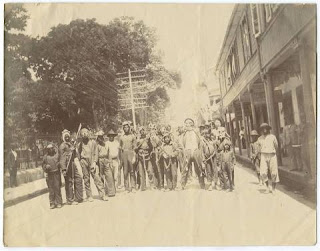STREET MAS, PORT OF SPAIN, 1896
In 1887, J.H Collens described the unrest of the Carnival of 1881 thus:
 “The two days immediately preceding Ash Wedne...sday are, as in most Roman Catholic countries, devoted to King Carnival. Business is partially, if not altogether, suspended ; masquerading and tomfoolery generally being the order of the day. The better class of Spaniards dress themselves in fantastic costumes and ride or drive about visiting their friends, showering small confitures upon them. The custom is gradually dying out, and of late years it has degenerated into the lowest form of buffoonery ; vulgarity and thinly-disguised obscenity being rather the rule than the exception. The roughs, rowdies, and diametres take advantage of the privilege of masking, and indulge in coarse ribaldry, till the police finally take them temporarily under their wing. These orgies used to begin with ' Canboulay.' Bands of ruffians armed with staves, calling themselves Bakers, Freegrammars, etc., each set having their leader, paraded the town of Port-of-Spain at midnight on the Sunday and fought each other,
“The two days immediately preceding Ash Wedne...sday are, as in most Roman Catholic countries, devoted to King Carnival. Business is partially, if not altogether, suspended ; masquerading and tomfoolery generally being the order of the day. The better class of Spaniards dress themselves in fantastic costumes and ride or drive about visiting their friends, showering small confitures upon them. The custom is gradually dying out, and of late years it has degenerated into the lowest form of buffoonery ; vulgarity and thinly-disguised obscenity being rather the rule than the exception. The roughs, rowdies, and diametres take advantage of the privilege of masking, and indulge in coarse ribaldry, till the police finally take them temporarily under their wing. These orgies used to begin with ' Canboulay.' Bands of ruffians armed with staves, calling themselves Bakers, Freegrammars, etc., each set having their leader, paraded the town of Port-of-Spain at midnight on the Sunday and fought each other,
annoyed the peaceably disposed, and even defied the police on occasions, if the latter presumed to interfere with them. Things got to such a pitch at last that the Government was compelled in the interests of Law and Order to put this down with a high hand. This caused some trouble at first, and not a little bitterness of feeling, but eventually Might, which for once was also Eight, prevailed, and the ' Canboulay ' as such has become a thing of the past. Peace he to its ashes !””
The Canboulay Riots only served to heighten the fever pitch of Carnival, for the Governor had reinstated the right of masqueraders to assemble in the streets of the capital after the unrest. By 1890, the street mas of downtown POS had become little more than a rabble, although the creativity of the chantwells (calypsonians) and the odd masquerade troupe could be lauded. The day of organized bands was still some years in the future but groups of poor people from the depressed barrack yards of East POS joined together to make merry in fine style. Using the materials at their disposal, they created colourful and jaunty costumes which mimicked the popular themes of the day. While the wealthy had Carnival dances and balls, the lower classes frolicked through the city in the wild abandon that is really the spirit of Trinidad Carnival. This photo from 1896 shows a typical street mas of the period.

Comments